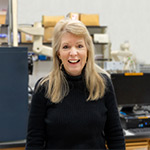
Disinfecting water is one of the major achievements of the 20th century — but it comes at a cost. Cleaning the water is a major benefit to public health, but it also leaves behind disinfection byproducts, which can lead to a host of maladies from bladder and colorectal cancer to birth defects to miscarriages. Of the more than 700 disinfection byproducts known to exist, there is little quality information on which ones are harmful and need to be regulated. Currently the U.S. Environmental Protection Agency regulates just 11 of them.
That is where Susan Richardson’s work comes in — especially the work she does with environmental engineers. For her work to improve water quality by measuring disinfection byproducts and other contaminants, Richardson has been elected to the National Academy of Engineering. It’s among the highest professional distinctions for an engineer.
But Richardson is not an engineer. She is a chemist.
“I was shocked. It completely caught me by surprise,” Richardson says. “I’m hugely honored. I would have never even dreamed or hoped for something like this.”
Thanks to an outstanding high school teacher, Richardson was inspired to pursue chemistry from a young age and explored fundamental questions like drug delivery in her Ph.D. program. Still, she craved work that felt more applied. With training in mass spectrometry — an analytical technique that allows scientists to pinpoint the unique “fingerprint” of different chemicals — she secured post-graduate work at the U.S. Environmental Protection Agency’s National Exposure Research Laboratory.

I want to make water safer. It’s a really important human health issue and I want to solve that problem.
Her interest in disinfection byproducts came about almost by chance. “I had never taken a single environmental chemistry class in my life. I was not an analytical chemist, I was a physical organic chemist,” says Richardson. “But I had expertise in identifying unknown chemicals, and that’s what they needed. They were looking for collaborators, and I had a high-res mass spectrometer and the right background and training to help identify unknown chemicals in drinking water.”
Working alongside engineers at North Carolina State University recently, Richardson helped investigate the use of beds of granular activated carbon — the material used in Brita filters — to absorb organic matter from water prior to the disinfection process. Removing that organic matter from the water and adding a little chlorine for disinfection was remarkably effective in controlling the level of byproducts and producing safer water. Another of her favorite treatments is to bypass use of chemicals entirely with UV light treatment.
In partnership with her graduate students, Richardson’s lab has also developed a range of methods to detect smaller and smaller quantities of trace chemicals. Thanks to their hard work and precision, Richardson’s team has a method that can quantify 72 different byproducts, over twice the amount done in other studies. Through her collaboration with a toxicologist at the University of Illinois, she has singled out the two most dangerous classes of these byproducts and presented her findings to the U.S. EPA to better inform policy decisions.
“I want to make water safer,” Richardson says. “It’s a really important human health issue and I want to solve that problem.”
Her work brings her into contact with toxicologists, engineers, risk assessors and a healthy sampling of the university’s chemistry students at both the undergraduate and graduate level.
“For big problems like this, chemists can’t do it by themselves; it’s important for us to collaborate to solve these kinds of problems,” she says. “But we can create sensitive, optimized methods. We’ve got more in-depth training in chemistry, and it gave me an edge in coming up with innovative methods for measuring DBPs and other contaminants in water at really low levels.”
Rather than feeling defeated by the prospect of an unseen and dangerous enemy, Richardson is energized by the methods and projects that are helping her make strides in the field of water quality issues — one of the most pressing public health problems of our age.
“We publish a lot of papers, and publishing pretty papers is one thing,” says Richardson. “But making a difference is a whole other thing. You’re collaborating with others and putting new practices in place to try to solve a big problem. That’s what drives me.”